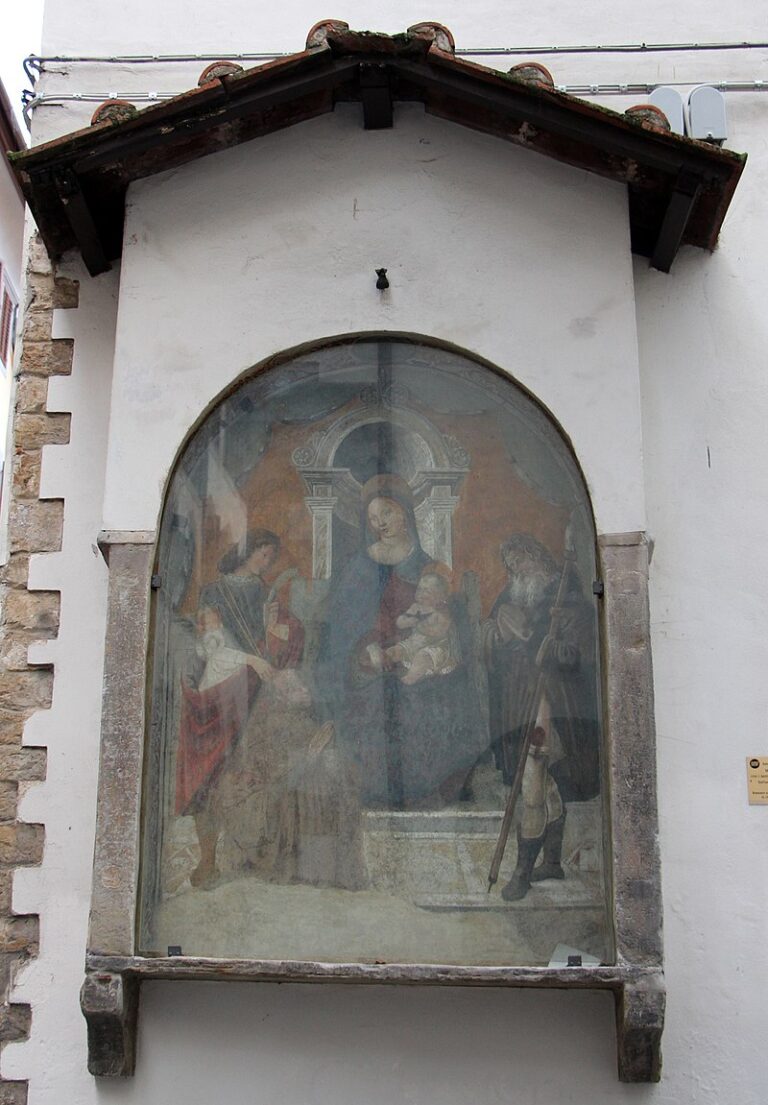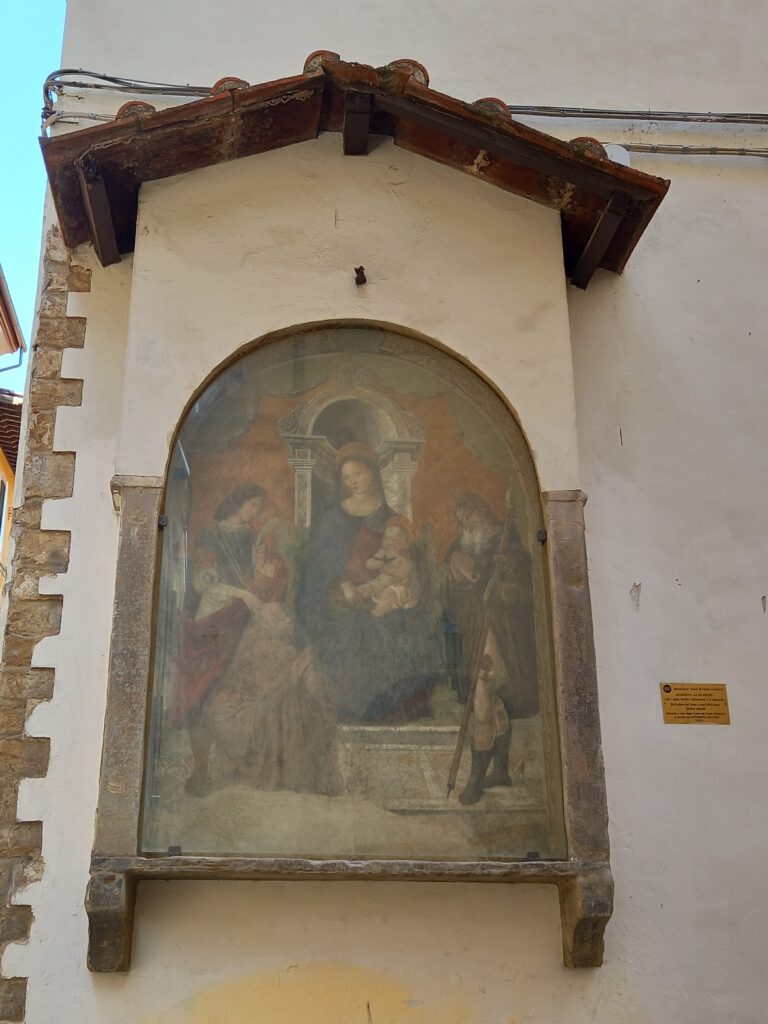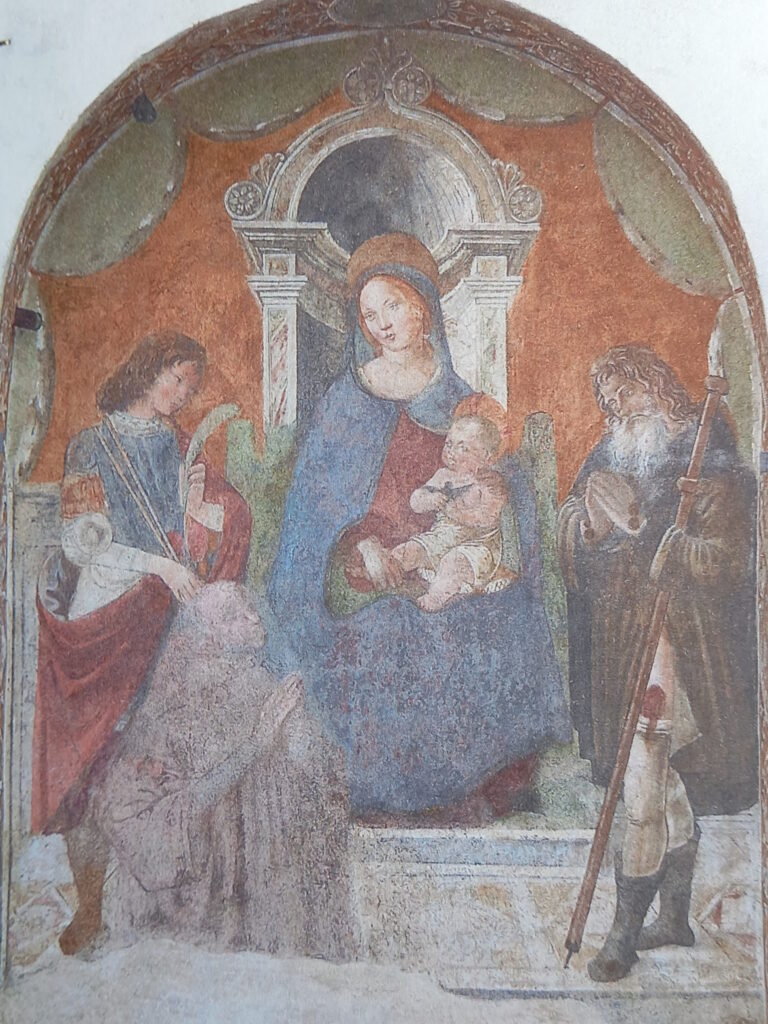Tabernacles of Florence
Via dei preti corner of via delle caldaie
THE TABERNACLE
Madonna col Bambino
In the fresco, the Virgin is depicted seated, as per tradition, on a throne covered with polychrome marble and adorned externally with scrolls and corollas of flowers; the back forms a deep niche, surmounted by a semi-spherical cusped calotte of classical inspiration, with the interior decorated in imitation of a shell. On its knees sits a sweet baby Jesus, holding a swallow in his hands; on either side of the throne, full-length, are San Sebastiano on the right presenting the patron and San Rocco on the left.
Tabernacle
Inside a tabernacle with pietra serena jambs is a valuable Sacred Conversation with the enthroned Virgin, the Child Jesus, St. Roch and St. Sebastian done in fresco. The aedicule is placed on the wall of the buildings that belonged to the convent of San Felice, built by the Benedictine monks of Nonantola in the 12th century next to the church of San Felice in platea, which existed in the previous century.
THE STREET
VIA DEI PRETI
This is a short cross street that runs from Via delle Caldaie to Borgo Tegolaio. It can be assumed that the name comes from the Canti Fiorentini, the ancestors of modern street nomenclature, which originated before 1300. In this specific case we could refer to the Canto dei Preti, which, together with the Canto alla Badessa, refers to the religious sphere. While, as far as Via delle Caldaie is concerned, the latter owes its name to the boilers of the Arte della Lana that numerous were located in the Oltrarno area and were used to heat the pieces to make the dyeing of cloth.
AUTHOR
Raffaellino del Garbo
(San Lorenzo a Vigliano, 1466 - Florence, 1524) The name "del Garbo," by which the painter is known, comes from Via del Garbo in Florence, where he kept his workshop from 1513 to 1517. He trained in Filippino Lippi's workshop, as evidenced by the information provided in Giorgio Vasari's Lives. His influences are related not only to Filippino but also to Pinturicchio and Lorenzo di Credi.
The artist
(San Lorenzo a Vigliano, 1466 - Florence, 1524) From 1501 to 1505 Raffaellino was engaged, among other things, in 'endowing' the Antinori, Frescobaldi, Nasi and Segni chapels in the church of Santo Spirito with no less than four eclectically different altarpieces. Of these only the one on the altar of the Segni chapel remains. The painting in the latter, stylistically, is the closest to our tabernacle and may share its date. If we compare the two Madonnas, we note that they present the same pose of the recumbent head turned to the right and the same oval with mellowed lines;
Curiosity
The presence of the two patron saints against the plague qualifies the devotional work as a product of a grace received by the patron, perhaps the same one depicted on his knees. A violent plague struck Florence in 1495 causing numerous victims, this was followed by a recrudescence in 1497-98; it is therefore plausible to associate this dramatic event with the tabernacle in question and to consider the year 1498 as the terminus post quem for dating the work.
OTHER INFORMATION
Info
AMICI DEI MUSEI FIORENTINI ODV - COMITATO PER IL DECORO E IL RESTAURO DEI TABERNACOLI - File by Daniele Rapino - Restorers: Valentini, Ventura - Work direction: Daniele Rapino - Restoration by Amici dei Musei Fiorentini in memory of Antonietta Sicuteri (2012)
PICTURES

Tabernacle
Via dei Preti corner of Via delle Caldaie

Tabernacle
Via dei Preti corner of Via delle Caldaie

Fresco: Madonna col Bambino
Via dei Preti corner of Via delle Caldaie
